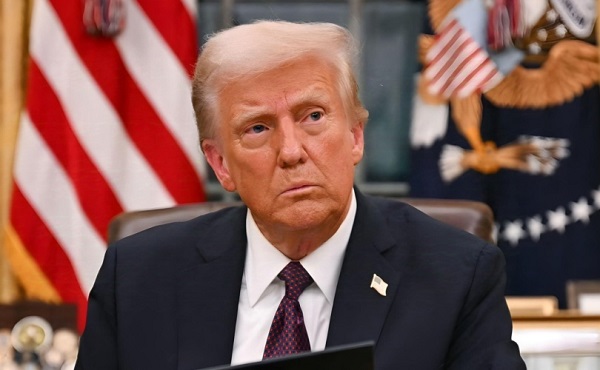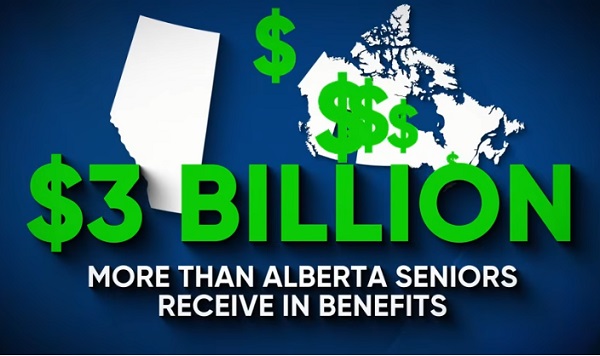Business
Trump’s dismantling of USAID is his biggest blow against the Deep State yet

From LifeSiteNews
By Frank Wright
Elon Musk’s DOGE has shut down USAID, immediately ceasing U.S. government funding of NGOs backing digital tyranny, mass migration, the ‘LGBTQ’ agenda, abortion – and a host of ‘regime change’ operations.
Donald Trump’s new administration has begun to dismantle globalist network funding of the policies of social revolution across the West – and beyond. With the revelations on the shuttering of USAID, Americans now know whose money is behind the Deep State: theirs.
Trump’s war on the Deep State has shocked the establishment. Elon Musk’s DOGE has shut down USAID, immediately ceasing U.S. government funding of NGOs backing digital tyranny, mass migration, the “LGBTQ” agenda, abortion – and a host of “regime change” operations including the funding of the origins of COVID-19 and the impeachment of Donald Trump himself.
These projects, and many more, were all paid for with U.S. taxpayer’s money through USAID.
This Deep State network of finance, influence and the subversion of democracy in the U.S., Britain, Europe and beyond remained unchanged in every election – until this one.
USAID, The U.S. Agency for International Development, “disbursed over 72 billion dollars last year,” according to a Newsweek report in October 2024, which described the now-defunct agency as “by far the world’s largest provider of humanitarian aid.”
So where is this “aid” going?
… and what sort of “humanitarian” projects has it been aiding?
“USAID is notorious for funding the most horrifying projects known to mankind,” as Mike Benz explains.
These projects include apparently funding the origins of COVID-19, “fake social media sites” to promote the overthrow of governments, heroin production and “fake HIV clinics” to promote regime change – as well as funding the prosecution of Americans, and U.S. election interference.
“USAID IS NOTORIOUS FOR FUNDING THE DARKEST, MOST HORRIFYING PROJECTS KNOWN TO MANKIND.” @MikeBenzCyber was shocked to learn about USAID’s role in taking down free speech in America. @AmandaHead @jsolomonReports pic.twitter.com/jWB8FlGoN8
— Real America's Voice (RAV) (@RealAmVoice) February 3, 2025
USAID’s “humanitarian” work included funding and directing the template for global digital governance in Ukraine, with its DIIA app, and funding the World Economic Forum which promotes the same agenda:
🚨🇺🇸 “I found out that USAid has been giving money to support the World Economic Forum”
“Why is the American Tax Payer funding The WEF when everyone that arrives there lands in a private jet” ‼️ pic.twitter.com/OHOdYHIbaL
— Concerned Citizen (@BGatesIsaPyscho) February 4, 2025
Its humanitarian efforts extended to sponsoring anti-Catholic propaganda in Ireland:
As Glenn Beck has pointed out, USAID was a major sponsor of abortion:
USAID is not a "humanitarian" effort. It's a CIA front. It's why the rest of the world HATES us.
In exchange for our tax dollars, we've asked countries to change their laws, accept abortion, promote transgenderism in their schools, open their markets to multinational… pic.twitter.com/eMhLyVhhTi
— Glenn Beck (@glennbeck) February 3, 2025
Here is a picture of ISIS terrorists in Syria in a USAID tent:

USAID was also funding “globalist propaganda” on the U.K.’s state broadcaster:
🚨 BBC FUNDED BY USAID – YOUR TAX DOLLARS FUELING GLOBALIST PROPAGANDA! 🚨
Not content with squeezing Brits dry through a ridiculous TV licence fee, the BBC has ALSO been dipping its hands into U.S. taxpayer money via USAID.
🔴 Hardworking Americans & Brits unknowingly funding… pic.twitter.com/3NQdAFViUC
— Jim Ferguson (@JimFergusonUK) February 4, 2025
Independent journalist Michael Shellenberger reported, “From 2004-2022, USAID was the largest U.S. government funder of EcoHealth Alliance, the group that funded the Wuhan Institute of Virology (WIV), which likely started the COVID pandemic.”
USAID sought to undermine and overthrow traditional and conservative national governments in Eastern Europe – and replace them with liberal-globalist ones:
Dmitry Arestovich, the former right-hand man to Ukraine’s Volodymyr Zelensky, now says USAID pressured the Ukrainian President into the war:
USAID funded “sterilization projects” in Peru:
And as LifeSiteNews reported in December 2024, USAID pressured African nations to change pro-life laws and promote mass abortions, but that did not stop Fr. James Martin from bewailing its demise.
USAID also paid “race rioters” to engage in violent protests in Africa:
At home, USAID sponsored the prosecution of U.S. citizens by “Soros-funded prosecutors”:
…and, as former Trump State Department staffer Mike Benz also asks, “Why did USAID pay $20 million to hit piece journalists to dig up dirt on Rudy Giuliani and use that dirt as the basis to impeach the sitting U.S. President in 2019?”
USAID was also giving “millions of dollars to Bill Kristol,” arch-neocon and founder of the permanent war “Project for a New American Century.”
The populist leader of El Salvador Nayib Bukele summed up the happy ending for the world that is the end of USAID.
“Most governments don’t want USAID funds flowing into their countries because they understand where much of that money actually ends up. While marketed as support for development, democracy, and human rights, the majority of these funds are funneled into opposition groups, NGOs with political agendas, and destabilizing movements.”
He explained how only “maybe 10% of the money reaches real projects that help people in need,” adding that “there are such cases” – but the remaining ninety percent, he says, “It is used to fuel dissent, finance protests, and undermine administrations that refuse to align with the globalist agenda. Cutting this so-called aid isn’t just beneficial for the United States; it’s also a big win for the rest of the world.”
Donald Trump’s war on the Deep State has just begun. It is not merely concerned with saving America, but his “common sense revolution” is a cure for a world made sick by a global network of death, deception and digital tyranny. He is uprooting the hidden international system which has promoted “LGBT, open borders and war” – as Hungary’s Viktor Orbán defined the values of the former regime.
This has been described as a “counter-revolution” by Archbishop Carlo Maria Viganò, who says these are serious moves against the “Deep State… and its mirror image, the Deep Church.”
With a serious campaign underway to destroy the business model of the globalist system it is hard to see how the rainbow “church” of Fr. James Martin can survive its isolation in a world without the patronage, propaganda and power of a corrupt Deep State and its globalist networks.
And the revolution does not stop with USAID. With moves to “purge” the FBI, audit the U.S. Treasury and all the agencies of the U.S. government, Musk’s Department of Government Efficiency is set to undertake a thorough cleanup of the White House and all it commands.
You might say the swamp is being drained.
However you frame it, what is happening here has never been seen in our lifetimes.
The secret state which directed politics and policy in the West despite elections is being exposed, defunded and shut down. We may not only have meaningful elections in future, but a Western society free of the propaganda of social revolution whose toxic “new values” had one thing in mind: the replacement of Christian civilization with a global government no one could ever escape.
Finally, after decades of destruction by design, things have really changed. For good.
Business
Dallas mayor invites NYers to first ‘sanctuary city from socialism’

From The Center Square
By
After the self-described socialist Zohran Mamdani won the Democratic primary for mayor in New York, Dallas Mayor Eric Johnson invited New Yorkers and others to move to Dallas.
Mamdani has vowed to implement a wide range of tax increases on corporations and property and to “shift the tax burden” to “richer and whiter neighborhoods.”
New York businesses and individuals have already been relocating to states like Texas, which has no corporate or personal income taxes.
Johnson, a Black mayor and former Democrat, switched parties to become a Republican in 2023 after opposing a city council tax hike, The Center Square reported.
“Dear Concerned New York City Resident or Business Owner: Don’t panic,” Johnson said. “Just move to Dallas, where we strongly support our police, value our partners in the business community, embrace free markets, shun excessive regulation, and protect the American Dream!”
Fortune 500 companies and others in recent years continue to relocate their headquarters to Dallas; it’s also home to the new Texas Stock Exchange (TXSE). The TXSE will provide an alternative to the New York Stock Exchange and Nasdaq and there are already more finance professionals in Texas than in New York, TXSE Group Inc. founder and CEO James Lee argues.
From 2020-2023, the Dallas-Fort Worth-Arlington MSA reported the greatest percentage of growth in the country of 34%, The Center Square reported.
Johnson on Thursday continued his invitation to New Yorkers and others living in “socialist” sanctuary cities, saying on social media, “If your city is (or is about to be) a sanctuary for criminals, mayhem, job-killing regulations, and failed socialist experiments, I have a modest invitation for you: MOVE TO DALLAS. You can call us the nation’s first official ‘Sanctuary City from Socialism.’”
“We value free enterprise, law and order, and our first responders. Common sense and the American Dream still reside here. We have all your big-city comforts and conveniences without the suffocating vice grip of government bureaucrats.”
As many Democratic-led cities joined a movement to defund their police departments, Johnson prioritized police funding and supporting law and order.
“Back in the 1800s, people moving to Texas for greater opportunities would etch ‘GTT’ for ‘Gone to Texas’ on their doors moving to the Mexican colony of Tejas,” Johnson continued, referring to Americans who moved to the Mexican colony of Tejas to acquire land grants from the Mexican government.
“If you’re a New Yorker heading to Dallas, maybe try ‘GTD’ to let fellow lovers of law and order know where you’ve gone,” Johnson said.
Modern-day GTT movers, including a large number of New Yorkers, cite high personal income taxes, high property taxes, high costs of living, high crime, and other factors as their reasons for leaving their states and moving to Texas, according to multiple reports over the last few years.
In response to Johnson’s invitation, Gov. Greg Abbott said, “Dallas is the first self-declared “Sanctuary City from Socialism. The State of Texas will provide whatever support is needed to fulfill that mission.”
The governor has already been doing this by signing pro-business bills into law and awarding Texas Enterprise Grants to businesses that relocate or expand operations in Texas, many of which are doing so in the Dallas area.
“Texas truly is the Best State for Business and stands as a model for the nation,” Abbott said. “Freedom is a magnet, and Texas offers entrepreneurs and hardworking Texans the freedom to succeed. When choosing where to relocate or expand their businesses, more innovative industry leaders recognize the competitive advantages found only in Texas. The nation’s leading CEOs continually cite our pro-growth economic policies – with no corporate income tax and no personal income tax – along with our young, skilled, diverse, and growing workforce, easy access to global markets, robust infrastructure, and predictable business-friendly regulations.”
Business
National dental program likely more costly than advertised

From the Fraser Institute
By Matthew Lau
At the beginning of June, the Canadian Dental Care Plan expanded to include all eligible adults. To be eligible, you must: not have access to dental insurance, have filed your 2024 tax return in Canada, have an adjusted family net income under $90,000, and be a Canadian resident for tax purposes.
As a result, millions more Canadians will be able to access certain dental services at reduced—or no—out-of-pocket costs, as government shoves the costs onto the backs of taxpayers. The first half of the proposition, accessing services at reduced or no out-of-pocket costs, is always popular; the second half, paying higher taxes, is less so.
A Leger poll conducted in 2022 found 72 per cent of Canadians supported a national dental program for Canadians with family incomes up to $90,000—but when asked whether they would support the program if it’s paid for by an increase in the sales tax, support fell to 42 per cent. The taxpayer burden is considerable; when first announced two years ago, the estimated price tag was $13 billion over five years, and then $4.4 billion ongoing.
Already, there are signs the final cost to taxpayers will far exceed these estimates. Dr. Maneesh Jain, the immediate past-president of the Ontario Dental Association, has pointed out that according to Health Canada the average patient saved more than $850 in out-of-pocket costs in the program’s first year. However, the Trudeau government’s initial projections in the 2023 federal budget amounted to $280 per eligible Canadian per year.
Not all eligible Canadians will necessarily access dental services every year, but the massive gap between $850 and $280 suggests the initial price tag may well have understated taxpayer costs—a habit of the federal government, which over the past decade has routinely spent above its initial projections and consistently revises its spending estimates higher with each fiscal update.
To make matters worse there are also significant administrative costs. According to a story in Canadian Affairs, “Dental associations across Canada are flagging concerns with the plan’s structure and sustainability. They say the Canadian Dental Care Plan imposes significant administrative burdens on dentists, and that the majority of eligible patients are being denied care for complex dental treatments.”
Determining eligibility and coverage is a huge burden. Canadians must first apply through the government portal, then wait weeks for Sun Life (the insurer selected by the federal government) to confirm their eligibility and coverage. Unless dentists refuse to provide treatment until they have that confirmation, they or their staff must sometimes chase down patients after the fact for any co-pay or fees not covered.
Moreover, family income determines coverage eligibility, but even if patients are enrolled in the government program, dentists may not be able to access this information quickly. This leaves dentists in what Dr. Hans Herchen, president of the Alberta Dental Association, describes as the “very awkward spot” of having to verify their patients’ family income.
Dentists must also try to explain the program, which features high rejection rates, to patients. According to Dr. Anita Gartner, president of the British Columbia Dental Association, more than half of applications for complex treatment are rejected without explanation. This reduces trust in the government program.
Finally, the program creates “moral hazard” where people are encouraged to take riskier behaviour because they do not bear the full costs. For example, while we can significantly curtail tooth decay by diligent toothbrushing and flossing, people might be encouraged to neglect these activities if their dental services are paid by taxpayers instead of out-of-pocket. It’s a principle of basic economics that socializing costs will encourage people to incur higher costs than is really appropriate (see Canada’s health-care system).
At a projected ongoing cost of $4.4 billion to taxpayers, the newly expanded national dental program is already not cheap. Alas, not only may the true taxpayer cost be much higher than this initial projection, but like many other government initiatives, the dental program already seems to be more costly than initially advertised.
-

 Energy1 day ago
Energy1 day agoB.C. Residents File Competition Bureau Complaint Against David Suzuki Foundation for Use of False Imagery in Anti-Energy Campaigns
-

 Alberta2 days ago
Alberta2 days agoAlberta uncorks new rules for liquor and cannabis
-

 COVID-191 day ago
COVID-191 day agoCourt compels RCMP and TD Bank to hand over records related to freezing of peaceful protestor’s bank accounts
-

 Crime2 days ago
Crime2 days agoProject Sleeping Giant: Inside the Chinese Mercantile Machine Linking Beijing’s Underground Banks and the Sinaloa Cartel
-

 C2C Journal23 hours ago
C2C Journal23 hours agoCanada Desperately Needs a Baby Bump
-

 International1 day ago
International1 day agoTrump transportation secretary tells governors to remove ‘rainbow crosswalks’
-

 Alberta1 day ago
Alberta1 day agoAlberta Next: Alberta Pension Plan
-

 Agriculture11 hours ago
Agriculture11 hours agoLacombe meat processor scores $1.2 million dollar provincial tax credit to help expansion




